
What you’ll learn:

How to tackle the growing complexity of B2B purchasing
Closing B2B deals is tougher than ever. Tight budgets and fierce competition have long been part of business sales, but today, the complexity of selling itself has grown dramatically. Large B2B enterprises now involve more stakeholders in purchasing decisions, with multi-layered organizational structures and extended approval processes.
At the same time, the rise of eCommerce for manufacturers, distributors and wholesalers — accelerated by younger, tech-savvy buyers — has shifted priorities from simply comparing products and prices to valuing service, convenience and seamless digital experiences. That being said, digital purchasing processes are evolving from basic transactions to fully integrated, automated workflows that handle complex orders, multi-step approvals and layered purchasing scenarios for both buyers and sellers.
In most B2B environments, a single purchase may require review and approval from multiple departments, including procurement, operations, finance and compliance, before a purchasing decision can be made. As you probably have experienced, coordinating these decisions manually is both cumbersome and prone to error.
Automation changes the game. By configuring access rights, defining roles and responsibilities, and applying rules across the buying process, sellers can create workflows that automatically manage quote negotiations, trigger the necessary reviews and enforce the correct approvals processes on the buyer’s side, and finalize orders efficiently and frictionlessly.
But the benefits go beyond convenience. Whether selling simple consumables or complex machinery, managing high-value, multi-million-dollar orders requires strict governance and security.
Roles and permissions must be precise, yet flexible enough to accurately reflect each buying company’s unique organizational structure — without limitations or compromise. This flexibility is essential, as buying processes can vary significantly between different customer groups and organizations. There is no one-size-fits-all approach to effective sales; flexible business modeling forms the foundation for true personalization in modern B2B buying and selling.
The foundation of B2B commerce: Modeling your organizational structure with commercetools
At the heart of B2B commerce lies the ability to accurately represent complex organizational structures, user responsibilities and buying workflows. With commercetools, enterprises can configure an organizational permissions model that gives them full control over who can do what and where, while retaining full flexibility.
This foundation is built on four key elements: Business Units, Associates, Granular Roles and Permissions and Approval Flows. In more detail:
Business Units (BUs)
Business Units represent a buying organization’s structure, such as subsidiaries, departments or regional branches. In other words, a BU refers to any type of ordering entity.
Each BU manages its own resources (orders, carts, shopping lists, etc.).
Sellers and associates can place orders, quotes and manage catalogs on behalf of their BU.
Scales from simple SMB setups (one BU = one company) to multi-layered enterprise hierarchies (one BU = a team within a department).
Collaborative purchase lists, in which multiple users contribute to a single list, can also be linked to BUs.
Associates
Associates are the various employees on the buyer’s side that could be involved in the purchasing process, such as procurement officers, finance approvers, engineers and office managers.
Associates are users tied to Business Units and can belong to multiple BUs, depending on their responsibilities.
Each associate can be assigned granular roles and permissions.
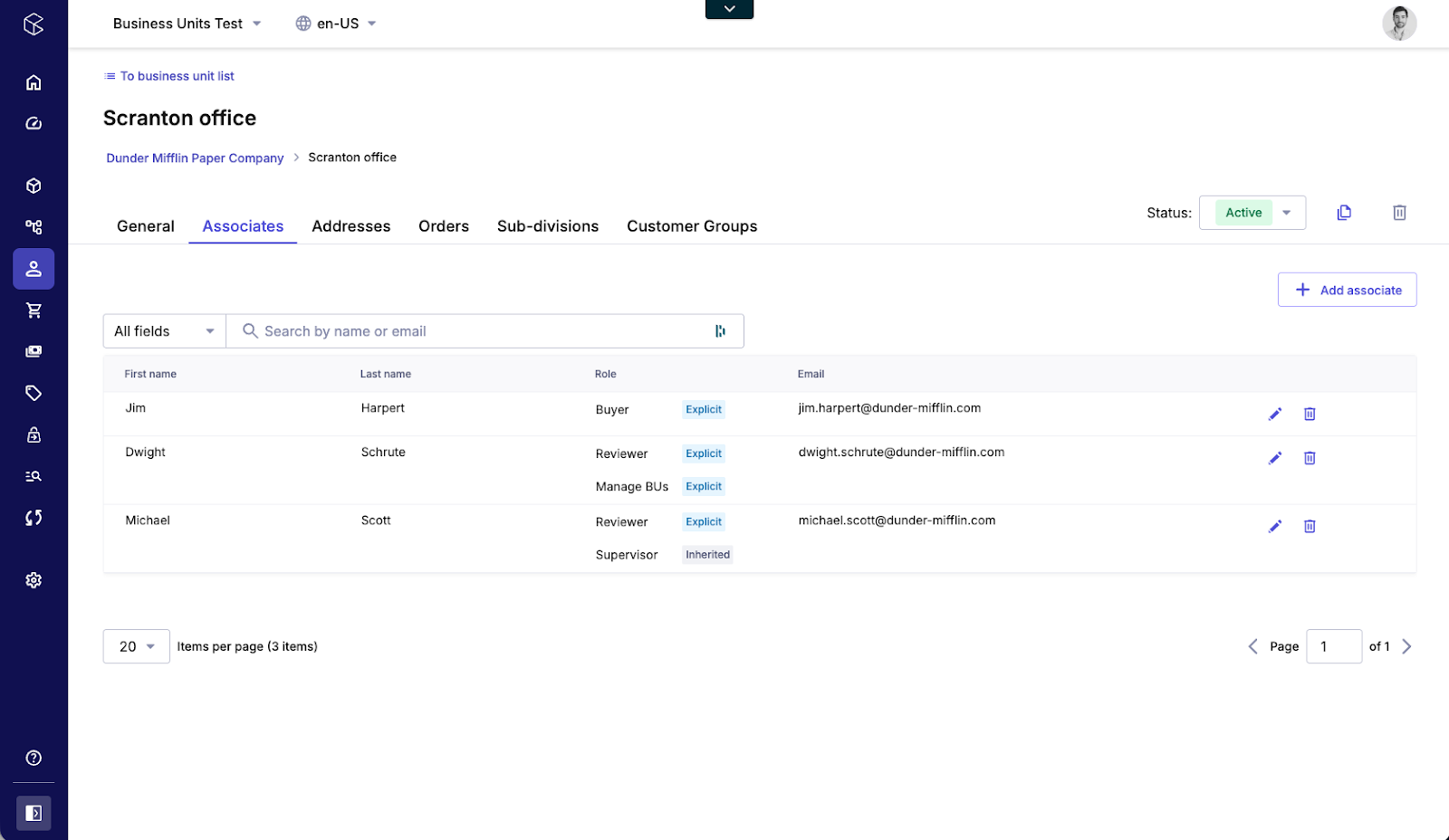
Granular Roles and Permissions
Each Associate can be assigned to granular roles (e.g. buyer, approver, admin), defining what each user is allowed to do within the system.
While out-of-the-box defaults include buyer, approver and admin, businesses can fully customize roles to match their real-world workflows, e.g., Procurement Manager, Lab Coordinator, Engineer.
Multiple roles can be assigned to a single associate to reflect overlapping responsibilities, i.e., a Lab Manager can be both a buyer and an approver for other buyers
Roles extend across other B2B features:
The management of the BU itself is regulated by permissions (e.g. creating subdivisions, adding associates, etc)
Access to Carts, Orders, Approval Flows, Quotes and Shared Purchasing Lists is fully governed by assigned permissions.
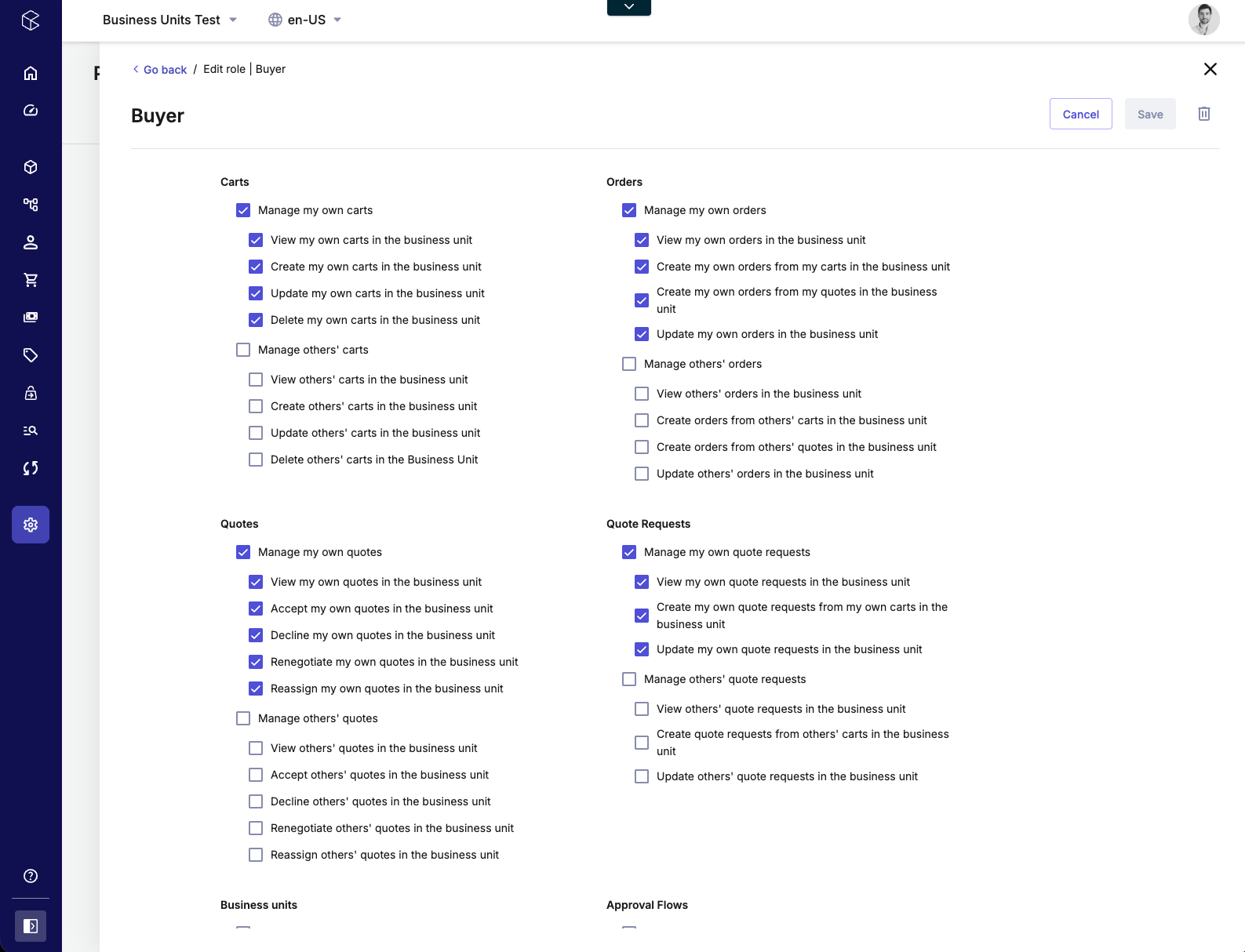
Approval flows
Approval flows enable organizations to define rules for order approval before processing.
Can be multi-tiered, ensuring compliance with internal procurement policies.
Conditions can be set based on various criteria such as purchasing thresholds (e.g., all orders above a certain value require manager approval).
Reduces risk and ensures compliance in complex purchasing environments.
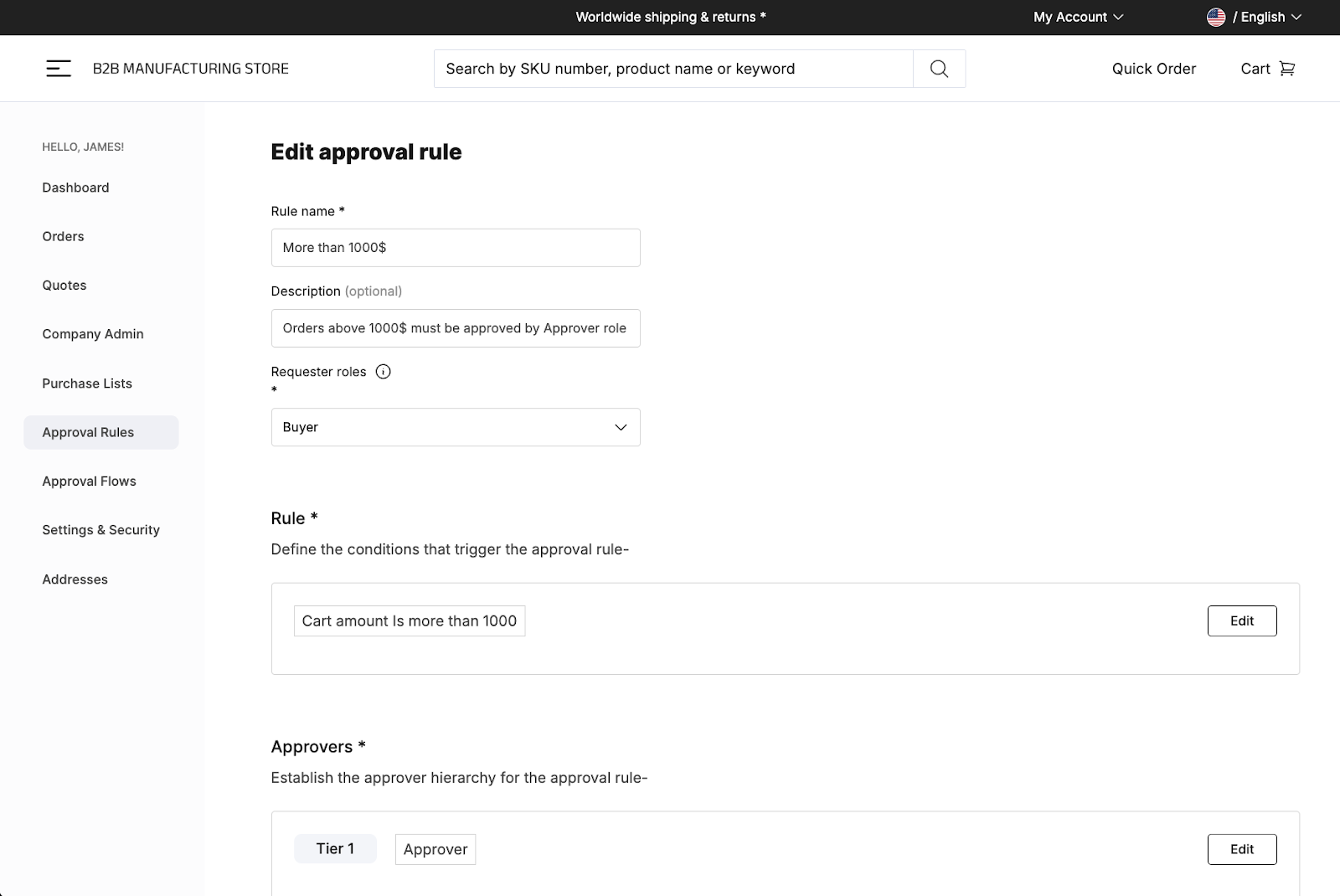
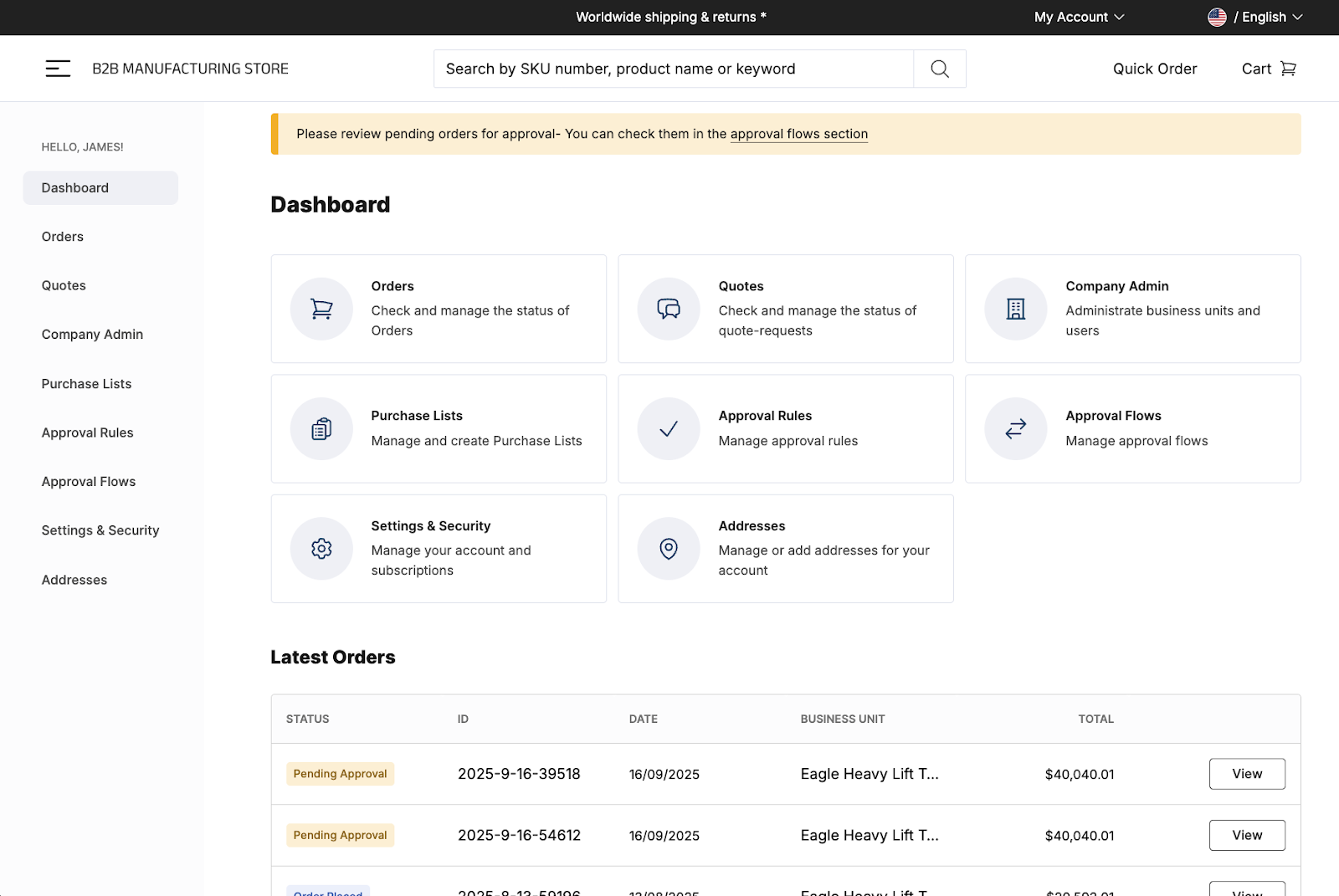
Why this matters
Automating the core of buyers’ hierarchical structure with granular roles and permissions enables sellers to:
Enhance operational efficiency by aligning permissions with real-world workflows.
Improve compliance and security by ensuring only the right people can act at the right time.
Provide flexibility to model the full gamut of simple to highly complex customer organizations (and everything in between).
APIs validate permissions automatically, ensuring that systems grant or deny access in real-time without manual intervention.
By defining specific roles, such as “Procurement Manager,” your business can then further utilize this data for added segmentation, personalized marketing and engagement, using commercetools’ Customer Groups for B2B.
At the core of organizational management with commercetools, scalability comes effortlessly — empowering enterprises to support complex, layered structures with ease.
Pre-set capacity limits include:
Up to 4,000 divisions per company.
Up to 2,000 associates per division.
Up to five levels of subdivisions.
Each associate can hold up to five roles.
These limits reflect the platform’s robust capacity for large-scale enterprises and can be extended even further as needed.
Flexible organizational modeling for every business
One of the biggest strengths of commercetools’ B2B foundation is its ability to flex to any type of customer structure — from the simplest to the most complex.commercetools’ key capabilities in action
Delivering true flexibility for B2B commerce requires more than just modeling Business Units and roles — it requires robust features that help enterprises manage complexity at scale.
commercetools makes this possible through five main capabilities:
Inheritance is essential for managing large-scale B2B customer structures because it allows you to set rules at a top level, such as consistent buyer permissions or inherited administrators, that automatically apply to all subdivisions. This minimizes repetitive manual configuration across thousands of Business Units and ensures that updates trickle down seamlessly and at scale.
It’s worth noting that the principle of inheritance applies not just to associates and their roles, but also to store terms, product catalogs and prices, giving enterprises fine-grained control while maintaining efficiency.
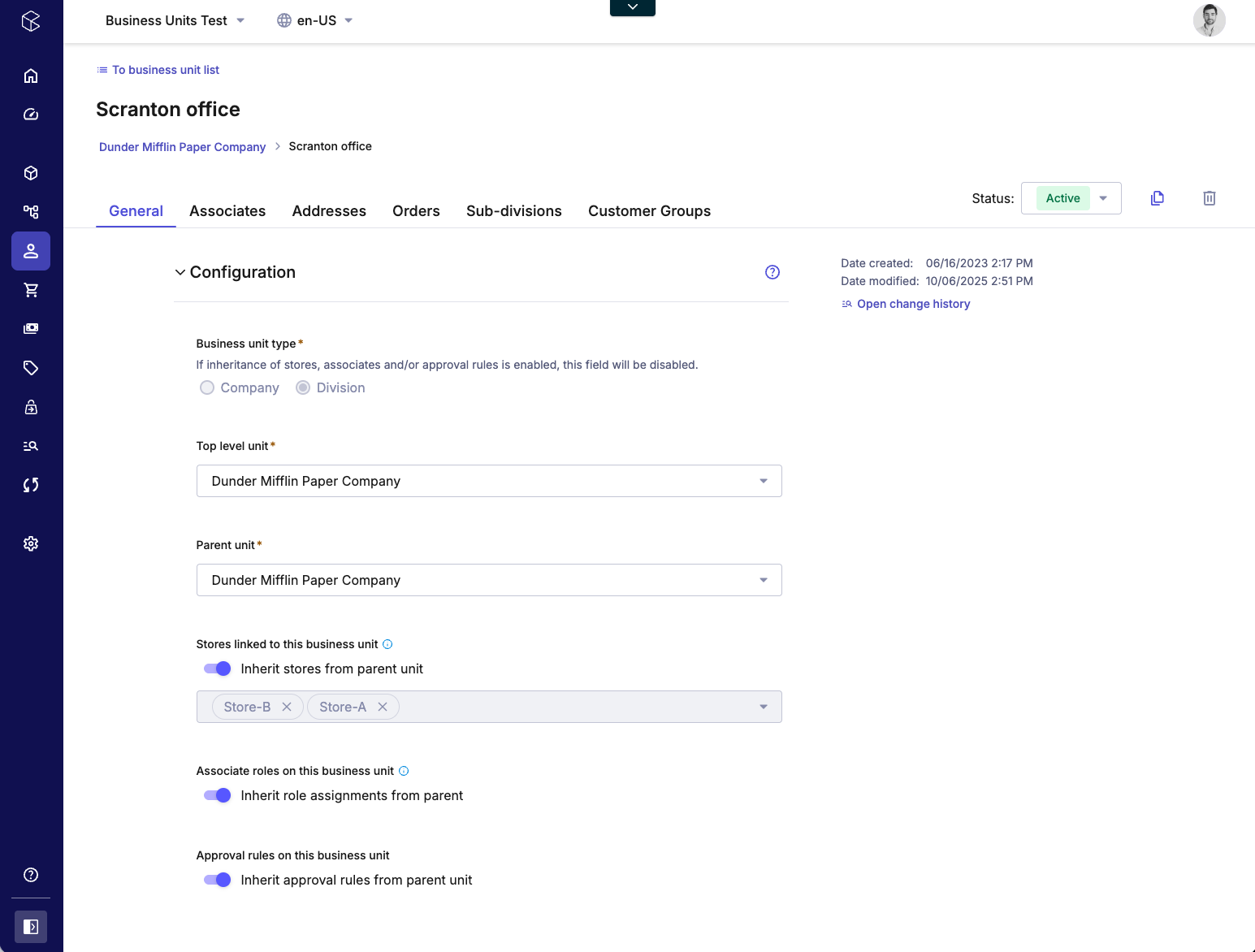
As B2B organizational structures and workflows can be highly complex, with multiple BUs, departments and approval hierarchies, providing enterprises with the ability to configure these details precisely is crucial. This ensures that orders, approvals and permissions align with real-world processes, reduces manual work and supports scalability as customer bases expand.
commercetools makes this possible through flexible configuration options:
Seller-managed configuration: B2B sellers can model their buyers’ organizational structures directly in the Merchant Center, commercetools’ admin portal. This provides centralized control over Business Units, associate roles, permissions and approval flows.
Buyer-managed configuration: Alternatively, sellers can empower their customers to configure their own organizational structures. Using commercetools’ API-first approach, sellers can build custom user interfaces (UIs) where buyers can set up their own Business Units, assign roles and define permissions in real time.
This dual approach offers maximum flexibility: Sellers can retain oversight where necessary, while buyers gain autonomy to manage their own structures. For enterprises with large or complex customer bases, allowing buyers to self-configure helps scale operations without overwhelming internal teams.
💡 Pro tip: Inheritance rules, which control how permissions and roles cascade across Business Units, can be configured either directly in the Merchant Center or through a custom buyer-facing UI built on top of commercetools’ APIs.
It’s often the case that B2B sellers need to create and update Business Units individually when onboarding and managing customers — a tedious and inefficient process for large-scale commerce operations.
To ensure your BU data is always up-to-date and synced across multiple systems of record, such as your ERP or your CRM, commercetools provides seamless import/export options. With the Import API, for instance, you can import and update BU data in bulk. Our import/export capabilities also mean your teams can export data, make bulk updates in external tools (e.g., Excel) and re-import it within the Merchant Center.
This helps your business accelerate onboarding of new B2B buyers and simplifies ongoing customer data management, increasing efficiency and reducing the risk of manual errors. Use cases include:
A B2B business migrating to commercetools can import its entire B2B customer structure, including all companies and their subdivisions, in a single operation.
A distributor can efficiently update details, such as addresses or associate roles, across hundreds of Business Units based on changes occurring in a third-party system, like the ERP or CRM.
In other words, this ensures that BU data can be imported from upstream systems, such as ERPs, either as one-off syncs during onboarding or as part of continuous integrations with daily updates. Additionally, this ensures that customer data remains accurate and up-to-date, which is vital for both protecting revenue and maintaining compliance.
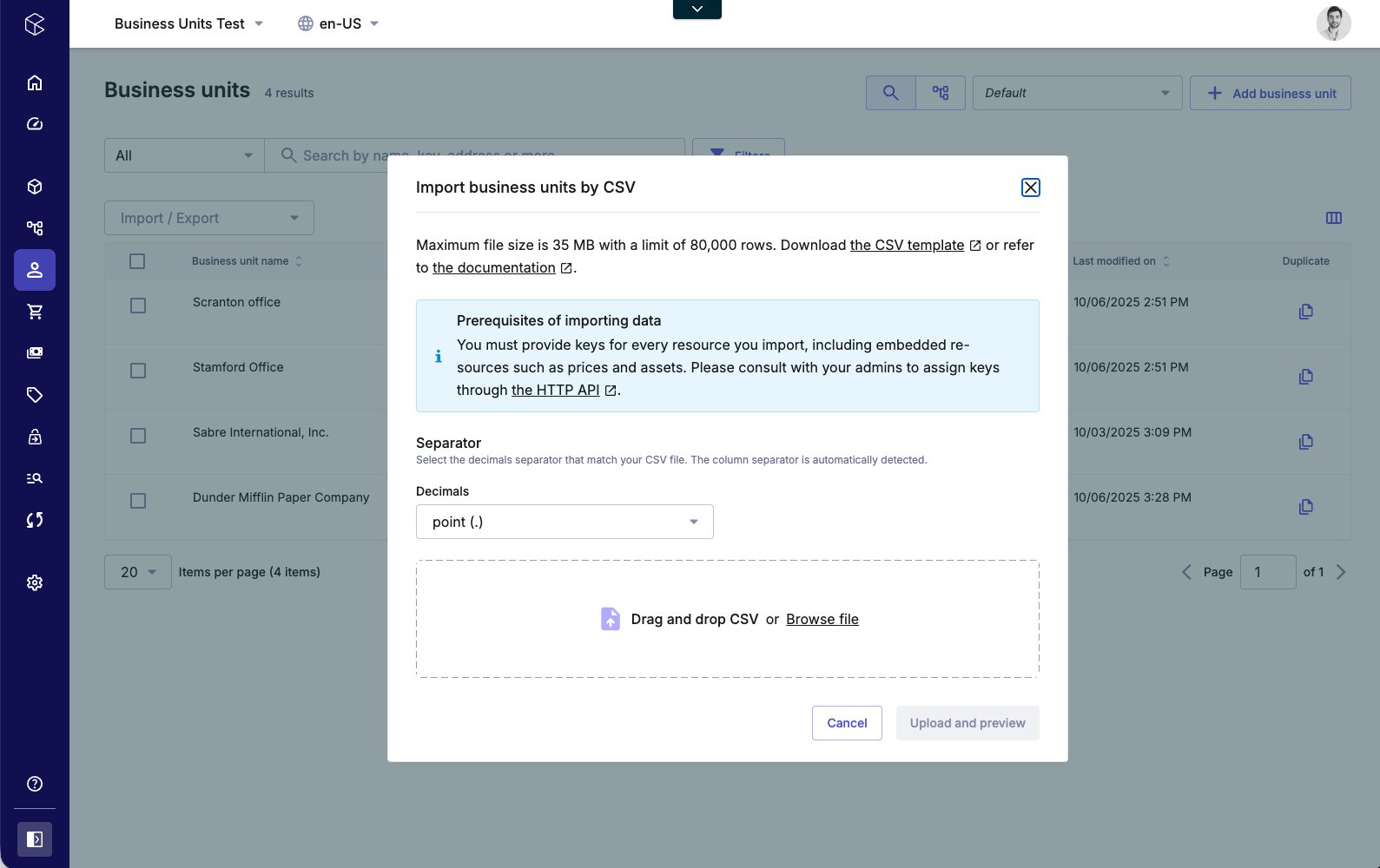
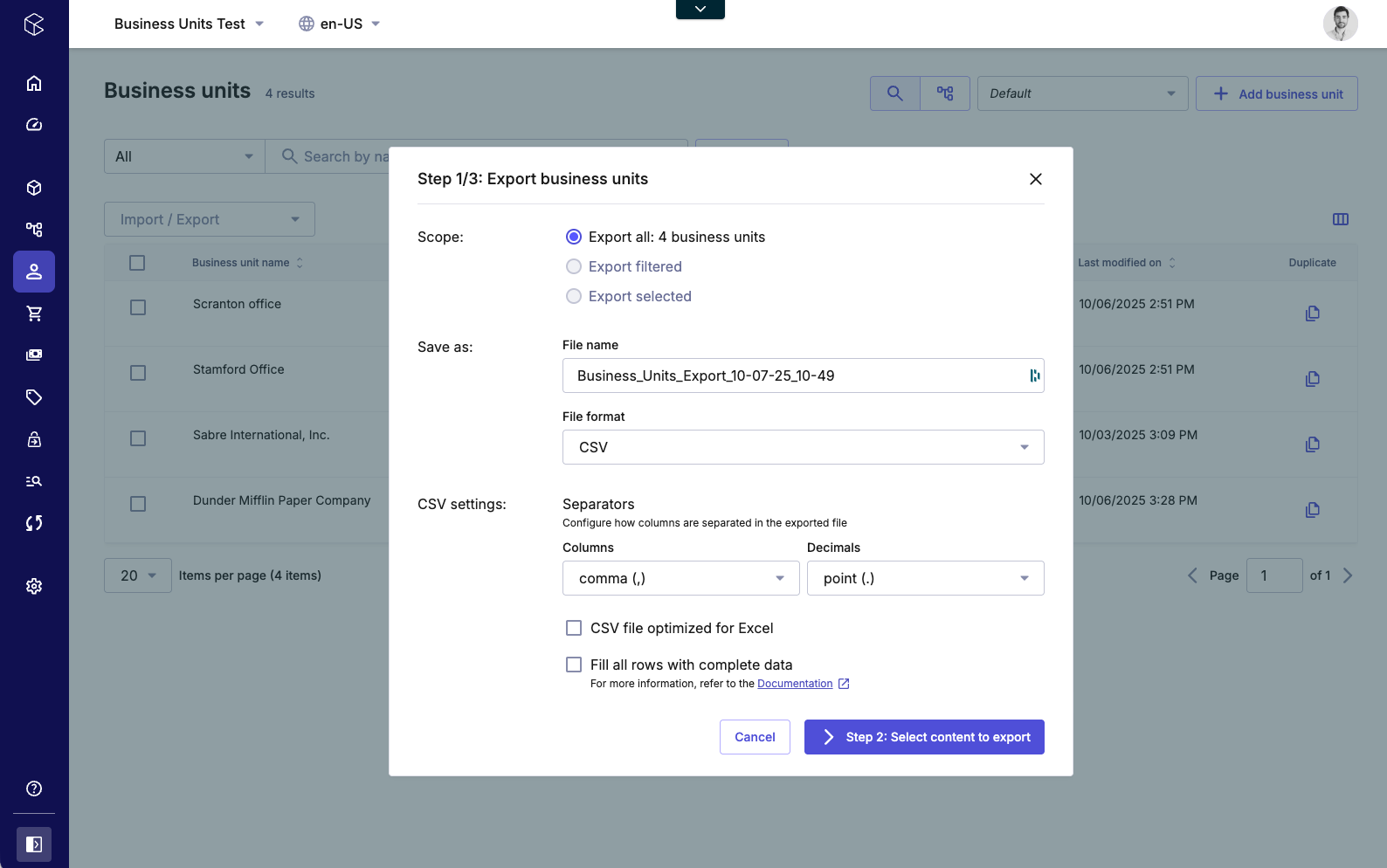
Leverage our Import/Export options
Organizations evolve constantly: Mergers and acquisitions happen frequently, subsidiaries split and new departments form. commercetools provides tools to reflect these changes without disrupting operations.
For permissions, negotiated entitlement terms and customer data to remain current, it’s vital to be able to update your configurations without hurdles whenever organizational changes happen. Again, performing these changes is possible through the Merchant Center, directly in our APIs and/or customer-specific UIs.
Tap into the Business Unit Search
A powerful Business Unit search search feature, available in both the Merchant Center and via API, enables customer service teams to quickly locate the correct customer records, improving speed, efficiency and excellence in CX.While commercetools’ B2B capabilities provide a growing number of attributes out of the box, each B2B organization is different, so being able to extend default business unit attributes with custom fields enables your business to capture industry-specific or company-specific details, such as:
Industry sector.
Operational region.
Contractor type.
Contract documents.
These extensible fields enable targeted promotions, tailored buying experiences and precise reporting, providing additional flexibility for B2B businesses. For example, tool suppliers can differentiate offers by contractor type or region, creating more personalized and relevant experiences.
Scale your B2B commerce
commercetools is taking B2B commerce to the next level, combining enterprise-scale capabilities with out-of-the-box simplicity. What once required custom extensions can now be handled natively, giving businesses the confidence to manage complex structures, roles and workflows.
By collaborating closely with customers, we’re shaping a bold future for B2B commerce — one powered by innovation, AI and smarter buying experiences.
This means your business can elevate its digital maturity faster by adopting integrated, automated and flexible B2B workflows that scale effortlessly, turning complexity into a competitive advantage while delivering superior experiences for both buyers and sellers.
Ready to try it out? Start your free trial.